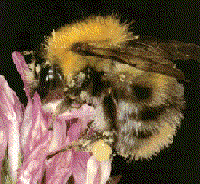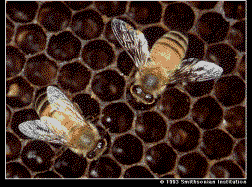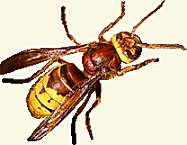Anaphylaxis has a number of possible causes, but this page covers the reactions to bites or stings by insects. I am not medically qualified... The information given here, is given in good faith, but you should consult a medical practitioner as only they have the requisite knowledge.
Adrenaline
Is the recommended treatment for anaphylaxis and is carried by those with a known history, in the form of a spring loaded Auto Injector syringe, or EpiPen, containing epinephrine. The device is covered in more detail in the link at the top of this page.
Piriton tablets, Piriton liquid, Ventolin tablets, Ventolin inhaler (salbutamol sulphate) may give relief in an emergency, BUT may not be administered without medical supervision, however if I were having trouble breathing... I would happily accept an offer of such treatment whilst I was waiting for an ambulance to arrive.
EpiPen Auto-Injector
ANYONE WHO IS LIKELY TO HAVE TO SELF ADMINISTER THE EPIPEN
AUTO-INJECTOR, or ADMINISTER IT TO OTHERS, SHOULD READ AND UNDERSTAND
THESE INSTRUCTIONS FULLY BEFORE AN EMERGENCY ARISES.
IMPORTANT: DO NOT REMOVE GREY SAFETY CAP UNTIL READY FOR USE.
The EpiPen unit is an automatic injection device containing epinephrine for allergic emergencies. The EpiPen Auto-Injector should be used only by a Hypersensitive (allergic) person in an allergic emergency as prescribed by a physician. Such emergencies may occur from insect stings or bites, foods, drugs or other allergens, as well
as idiopathic or exercise-induced anaphylaxis.
THE EPIPEN AUTO-INJECTOR is a disposable, pre filled automatic injection device which is designed to deliver a single dose of 0.3 mg of epinephrine.
- Keep the EpiPen Auto-Injector ready for use at all times.
- Protect from exposure to light and extreme heat.
- Note the expiration date on the unit and replace it prior to actual expiration.
- Replace any Auto-Injector if the solution is discolored or contains a precipitate. The EpiPen Auto-Injector is designed with a see-through window to allow periodic examination of its contents. The physician may recommend emergency use of an Auto-Injector with discolored contents rather than to postpone treatment.
EMERGENCY TREATMENT OF ALLERGIC REACTION/ANAPHYLAXIS
If you experience the signs and symptoms described by your physician, use the EpiPen Auto-Injector immediately, through clothing if necessary. If you have been stung by an insect, remove the insect's stinger with
your fingernails if possible; do not squeeze, pinch or push it deeper into the skin. If available, ice packs or sodium bicarbonate soaks may then be applied to the area stung. Keep warm and avoid exertion.
NOTIFY YOUR DOCTOR IMMEDIATELY OR REPORT TO THE NEAREST HOSPITAL
If you have used EpiPen, be sure to explain to the physician that you have received an intramuscular injection of epinephrine.
 Grey Safety Cap
Grey Safety Cap

DIRECTIONS FOR USING EPIPEN AUTO-INJECTOR
- Pull off gray safety cap.
- Place black tip on thigh, at right angle to leg (see illustration at right). (Always apply to thigh.)
- Press hard into thigh until Auto-Injector mechanism functions, and hold in place for several seconds. The EpiPen unit should then be removed and discarded. Massage the injection area for 10 seconds.
EpiPen should only be injected into the anterolateral aspect of the thigh.
Accidental injection into the hands or feet may result in loss of blood flow to the affected area and should be avoided. If there is an accidental injection into these areas, advise the patient to go immediately to the nearest emergency room for treatment.
The principal stinging insects belong to a group called Hymenoptera. Some examples of which are illustrated below.





The types above from left to right are... Bumble Bee, Honey Bee, Solitary Wasp, Top... Common Wasp, and extreme right... Hornet.
The pictures are in proportion apart from the solitary wasp, which comes in many sizes and colours, the largest being similar to that depicted and the smallest being smaller than the common wasp at top right.
Suggestions for avoidance of insect stings
OUTDOORS: Keep food in covered containers. Keep garbage containers covered and avoid open garbage receptacles.
PERSONAL: Avoid using strong perfumes found in hair sprays, hair tonics, suntan lotions and other cosmetics. Avoid wearing brightly colored clothing, flowery prints, or black. as this color seems to attract insects more than white, green, tan or khaki garments. Wear shoes at all times when out of doors. If possible, keep arms and legs covered by garments.
The upper part of this page has been prepared from a patient leaflet produced by Center Laboratories, Washington, USA, printed in 1993.
Dried Bee Venom
In recent years it has been noticed that breathing in particles of dried bee venom that have been associated with
beekeeper's clothing has caused a number of Hyper Allergies among beekeeper's wives and families.
An alternative view expressed an ambulance medic with many years of experience.
"I can understand both sides of the debate about the use of an EpiPen. Anaphylaxis can and does kill... However there can also be very serious side effects to the use of an EpiPen, including death in extreme cases. The key point is to recognise when the use of the EpiPen is justified."
Some doctors are reluctant to prescribe the EpiPen because they feel that some people may not be able to make the distinction between a localized reaction coupled with stress and excitement in comparison to a systemic reaction.
The body's natural reaction to foreign substance is to try to restrict it's spread and deal with the suspected poison a small amount at a time. It does this by the release of histamine at the site of injury or the sting. Redness and swelling result as the substance is locally retained. As the substance dissipates the swelling reduces and the site returns to normal. Over time, the body can learn that the bee venom is really no big threat and the reaction to the stings can diminish to the point of the body not over-reacting to it.
In the case of anaphylaxis there is a systemic release of histamine causing the body tissues to release histamine in the 'wrong' places. Blood vessels can dilate and cellular tissue become leaky causing a drop in blood pressure and swelling in areas of the body other than the site of the sting. If the site of swelling involves the airway, or if the blood pressure drops too much, the impact on the body can be catastrophic.
Epinephrine delivered by way of the Epipen has the effect of tightening the blood vessels, increasing the heart rate, and dilating the passages of the airway. The first two effects listed can have a serious effect on a weak heart if there is nothing basically otherwise wrong with the person except a high level of excitement, accompanied
by hyper ventilation, difficulty breathing and only a local reaction to the sting. On the other hand, for someone that is in a real crisis from a fully systemic reaction, the effects are exactly what the person needs - an increase in blood pressure and a wide open airway.
The key point is the recognition of anaphylaxis as opposed to a local reaction. A great majority of doctors agree... That a heart patient over 40 years of age, in anaphylactic shock is in need their blood pressure and airway returned near normal by way of injectable epinephrine.
All beekeepers that are concerned about sting reactions should have the ability to fully recognise the signs and symptoms of anaphylaxis before they administer an EpiPen".
 Grey Safety Cap
Grey Safety Cap




